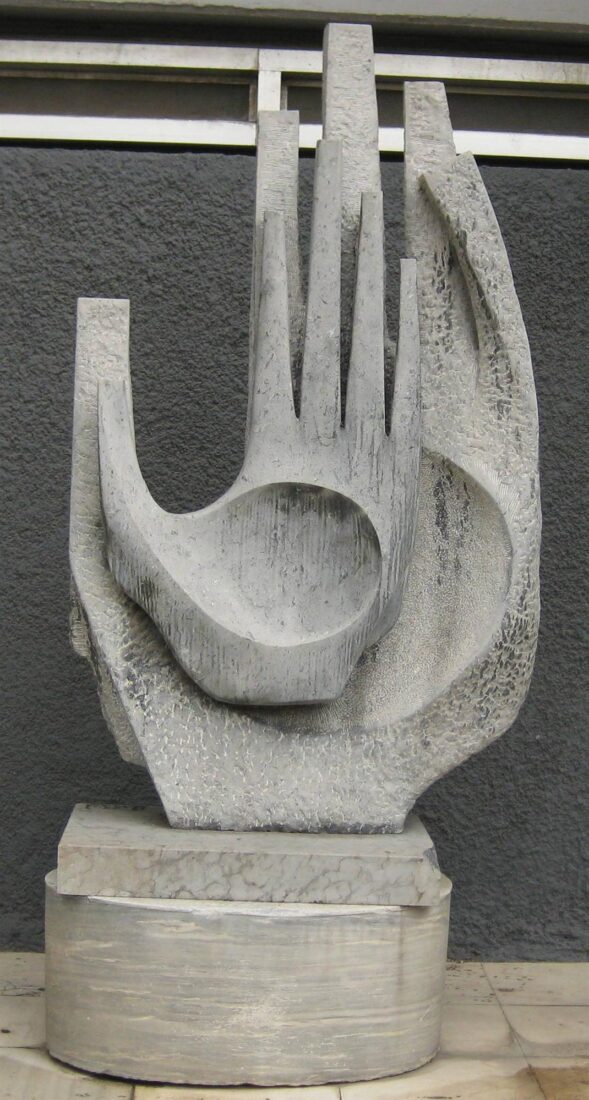




The seated female figure constitutes the basic subject in the sculpture of Giorgos Georgiadis. After a period in which he was involved with subjects taken from everyday life rendered in a highly generalized fashion, without any emphasis placed on detail, he adopted an expressionistic style, radically distorted, which has come to characterize his work since the end of the Sixties. The main subject now is a ponderous, fleshy female figure, usually headless and armless, with a broad lap and thick legs with large cracks in them, without feet, and wrapped very tightly in a piece of fabric leaving the breasts naked. This figure, whether seen in isolation or in combination with other figures, is transformed into a symbol and means of expressing criticism or protest regarding current social or political situations. The series “Paean”, which employs the well-known female figure, repeated in a variety of laudatory attitudes, as expressed through the figures’ uplifted arms, the lute and the drum, comes as a retort, meant to express an optimistic outlook and to send a message of hope.


Froso Efthymiadi studied pottery-making in Vienna and for a long period made works exclusively in terracotta in a realistic manner. In 1955 she abandoned terracotta and turned to the use of metal, while the realistic rendering began to lessen and the figures became very abstract, but without the physical form itself becoming unrecognizable.
The female figure provided the spark for the creation of a multitude of both small and large compositions which, sometimes static and other times in motion, set forth the personal view of the sculptor in regard to the rendering of female charms.
From around the end of the Fifties she started using hammered metal rods. The rods were welded together having empty spaces left between them, thus allowing space to enter the work and become a dynamic element in the composition. A “Nike” from 1960, done in hammered bronze and reshaped into practically a straight line, is an ethereal and dynamic form of the ancient image of the “Winged Victory (Nike) of Samothrace”, as it surges forward freely and impulsively and is imposed on space with the assistance of the empty space, which is spontaneously transformed into a natural background. In 1969, the rendering of movement became even freer, as the bronze rods were polished, widened and transformed into ribbons which bend and wind around empty space suggesting the body in “Nike II”, which now seems not only to be rushing ahead but to also be swirling around in a victory dance.

Frosso Efthymiadi studied ceramics in Vienna and for a long period made realistic works exclusively in terracotta. In 1955 she abandoned terracotta and turned to using metal. At this time her work became very abstract, but the physical form always remained recognizable.
The female figure sparked the creation of many small and large compositions. Sometimes static, elsewhere in motion, these pieces formulate Efthymiadi’s personal view of the harmonious rendering of female grace.
“Lot’s Wife” is her only work that portrays a religious figure. For its rendering, Efhymiadi borrowed the shape of an organic form – a tiny ordinary seashell. With this she conveyed the pure form of a woman who turned into “a pillar of salt.” The very shape of the shell offered the solution for the creation of the work, with its endless coiling and uncoiling. Schematic but totally recognizable, “Lot’s Wife”, wound in her cloak, stands petrified, motionless and silent.

Christos Kapralos shaped his personal style by assimilating the teachings of ancient Greek and folk art together with European avant-garde tendencies.
His first sculptures were simplified realistic figures in terracotta and plaster, inspired by his immediate environment. He began using bronze in 1957. The human body became transformed into Victories and mythological figures, ancient hoplite soldiers, couples, and mothers with children. At the same time, Kapralos’ compositions became highly abstracted and often fragmented. The fragmented rendition and the intentional, exaggerated distortion gave his work its dramatic character, or emphasized that quality. In some cases this dramatic quality is immediately recognizable, whereas elsewhere it manifests itself indirectly, provoking a variety of associations in pieces that are simply titled “Composition”.
“Vietnam” is characteristic from this standpoint. It is yet anoth Composition, whose content is eloquently declared in the inscriptions engraved on the piece itself: “VIETNAM” and “DICTATORSHIP SHAME”. Kapralos thus expressed his protest against a catastrophic war and a dreadful period in recent Greek history that coincided with it chronologically. The two converging, mutilated figures support one another and, despite their tragic deformities, remain upright like symbols of hope and victory.

